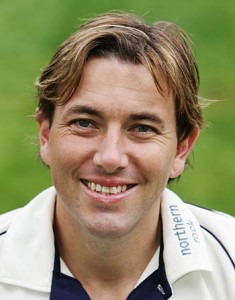
A gradual but inevitable descent into cricket-based loathing and bile.
Whatever Happened To The Unlikely Lads? #40: Chris Silverwood
One of the common examples of modern cricketing parlance is the phrase ‘next cab off the rank.’ Basically this is bandied around whenever potential selections are discussed and its use implies that cricketers patiently await their turn to play for England. The increase in the use of the term is probably due to a more predictable and consistent selection policy than was previously the norm. But once upon a time, England had a different style of selection. It wasn’t that the taxi rank was especially unordered – rather that like Bristol city centre after 2am, there were no cabs to be found at all. The result of this was that any vehicle was an empty back seat was liable to be hailed. And as far as this Unlikely Lad is concerned, it was a cheaply-made car with dodgy brakes, a broken door and a lingering smell of sick.
#40: Christopher Eric Wilfred Silverwood
Back in the days when Reef and Mansun were able to have number one albums and Nick Knight wasn’t a complete tool, England used to rotate their bowlers, through a combination of frequent injury and befuddled leadership, in a manner that was eerily similar to Channel 4’s choice of presenters on RI:SE, despite predating that ill-fated show by a few years. But this was before rotation was what all the cool kids and cricketing authorities did and was essentially England opting for any fastish bowler with two working legs and a back that wasn’t made of plasterboard. England played 81 Tests from 1996 to the end of 2002, but the only bowlers to play more than 30 of these were Andy Caddick and Darren Gough (in the interests of fairness, we should also note that from 2006 to 2012, only Jimmy Anderson and Stuart Broad played more than 30 Tests). The rest of the attack was chopped and changed as if they were Mark Durden-Smith, Kirsty Gallagher and Tom Binns. Anyway, this seemingly-arbitrary time span is more-or-less commensurate with the international career of today’s hero. A career that was as memorable as the night our gin was spiked with vodka, or indeed an episode of RI:SE.
In total, Silverwood played six Tests (unusually, all six appearances came in the southern hemisphere) and seven ODIs (of which one was at Lord’s and the rest spread across New Zealand and Zimbabwe). He debuted in the infamous match where England flippin’ murdered Zimbabwe along the way to drawing with the scores level. Despite taking 3/63 and 1/8, he was replaced for the next game by Craig White. He also featured in the two ODI series that winter – playing all three games against Zimbabwe (England lost all three – halcyon days indeed) and the final two against New Zealand (England lost both to be defeated 3-2, despite winning the first two games). He finally experienced an international victory against Australia in 1997 – famously Ben Hollioake’s debut – but his six overs went for 44 wicketless runs.
He was then outcast from the England team until 1999, when he was selected to tour South Africa. Playing in four Tests, including the notorious fifth at Centurion, his only significant contribution was a five-wicket haul in the fourth match. After a few more years stuck in county cricket, he was selected for the Ashes tour of 2002. Picked to play at Perth, he managed four expensive overs before getting injured, never to return. Tellingly, across this period, as well as the aforementioned Caddick and Gough, the following bowlers gained more Test caps than Silverwood: White, Cork, Flintoff, Hoggard, Headley, Fraser, Mullally, Tudor and Ealham.
His county career was predominantly ‘not bad’, playing for Yorkshire from youth until 2005, followed by a few twilight years at Middlesex. Considering his England caps, it is surprising that he only took 50 first-class wickets in a season three times – and one of those was in 2006 long after he had faded from international potential – but it was in an era when Yorkshire had a plethora of decent bowlers who would share the wickets. Conversely, he also benefited from Headingley wickets. Basically, what we’re saying is that if England bowlers of the late 90s and early 00s were in fact a queue of taxis, then Silverwood would have been prowling the backstreets looking for victims of crime in order to get a fare. Which is coincidentally what Mark Durden-Smith is apparently up to these days.




No Comments
Post a Comment